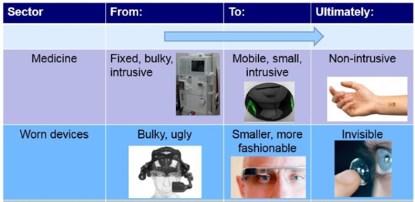



Feature Story
More feature stories by year:
2024
2023
2022
2021
2020
2019
2018
2017
2016
2015
2014
2013
2012
2011
2010
2009
2008
2007
2006
2005
2004
2003
2002
2001
2000
1999
1998
 Return to: 2015 Feature Stories
Return to: 2015 Feature Stories
CLIENT: IDTECHEX
Aug. 3, 2015: EE Times
Raghu Das, IDTechEx
Wearable technology will take off when people can wear it, not when the technology wears people, as it mostly does today.
Three years ago, wearable technology was just getting off the ground. Fast forward to 2015: today, a wide host of players -- from satnav companies to mainstream consumer electronics companies -- are hawking wearable electronics products on the market, yet the past three years have borne witness to an intense period of many booms and busts in the wearable industry.
In part, wearable technology is driven by consumer electronics companies seeking the next big thing as the impending saturation of smart devices and tablets becomes frighteningly apparent. However, this is still an embryonic industry, with the opportunity being more important than immediate sales, and companies will keep evolving products until they find what's right. That's difficult when there can be so much expectation for companies to get it right first time. Take Google Glass, for example; this has proved to be a flop initially, but it's a concept that is far from dead in the Google labs.
Consumers want to be connected -- preferably without carrying around bulky things -- but wearable technology devices just aren't there yet. For example, many wearers of fitness bands tire of the daily battery charging process once they feel they have learned enough from the data provided. Then there is the trend of cell phones is to move to bigger displays -- something that is desired by consumers, but that doesn't marry up well with a much smaller rigid display worn on your wrist. The jury -- that is, consumers -- do not appear to be convinced that this is a format that works.
Additionally, the current approach of conventional electronics that you strap onto yourself has resulted in rapid commoditization, seeing margins being driven down rapidly. Indeed, detailed reference designs for nearly every type of consumer wearable device can be readily found online. Component manufacturers globally provide this information as a marketing tool, with simple block diagrams indicating the array of offerings they can provide for each component type.
The majority of devices available have adopted component platforms developed for cell phones into wearable products, as shown in the figure below. It is therefore not too much of a surprise that today's wearable technology products are met with mixed review.

Source: IDTechEx Research.
The future will be very different because it will involve the use of new types of electronics -- namely thin, conformal, flexible, invisible, distributed, and textile-integrated components that are just beginning to emerging from research labs.
For example, flexible batteries have already enabled companies such as Estee Lauder and BioBliss to bring "powered" cosmetic skin patches to market, whereby the battery applies a voltage over the skin, opening the pores up, allowing the cosmetic to go in up to 10 times faster than without a power source. Used for anti-wrinkle treatment, the application would not be practical with a thick, rigid button cell battery. It comes as no surprise then to report then that Samsung, LG Chem, and Apple have all developed or acquired flexible, thin film battery technology in the last few years as they seek to unshackle themselves from the constraint of bulky rigid batteries.
Battery technology development has otherwise lagged behind most other forms of computing progression over the last five decades. Wearable devices are plug-in constrained. This is driving work on energy-harvesting systems, including tribology harvesting energy from friction between layers of material, for example, to motion harvesting in the form of electrodynamic or piezo electric harvesters.
Flexible and printed sensors of many types are also in development. Unlike discrete sensors, these can be distributed, conformal to the wearer and monitor. One example of their use is health statistics in a non-intrusive way. Indeed, the humble powered cosmetic patch is being developed to sense the need for medicine and to then release the drug molecules accordingly. Flexible sensors will help to overcome the lack of comfort to wearers that may otherwise prevent them from wearing the patch for long periods of time.
This next generation of wearable sensors is beginning to emerge. It includes flexible stretch and pressure sensors for incorporation into clothing; skin patch sensors for measuring features such as chemical concentration and temperature; and new materials for dry electrodes enabling electrical measurement of the body in a comfortable, reliable way. The difference with these sensors is that they are being designed from scratch to suit the needs of wearable devices, with appropriate form factors, material properties, power consumption, and lifetimes.
Then there are textile integrated electrics and electronics, with devices already on the market, including the Mimo baby monitor that features textile integrated electrodes that can be washed.
As a result of all these factors, the wearable technology market will rise three-fold over the next 10 years, from $24 billion to $72 billion by 2025 (the majority of this increase being in established devices such as earphones), with growth enabled by many new technology innovations becoming available now and over the next few years. In the meantime, there will continue to be boom and bust wearable gadget makers. The winners will be the technology innovators and those that integrate the new components. Wearable technology will take off when people can wear it, not when the technology wears people, as it mostly does today.
IDTechEx assesses all emerging technologies, including flexible displays, sensors, batteries and textile electronics. These will also be showcased at the IDTechEx Wearable USA event, which will take place November 18-19, 2015 in Santa Clara, California.
Raghu Das is CEO and Principal Analyst at IDTechEx (IDTechEx.com).
Return to: 2015 Feature Stories